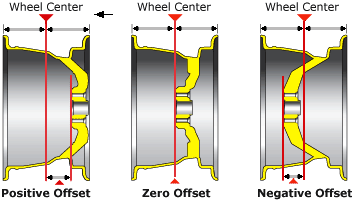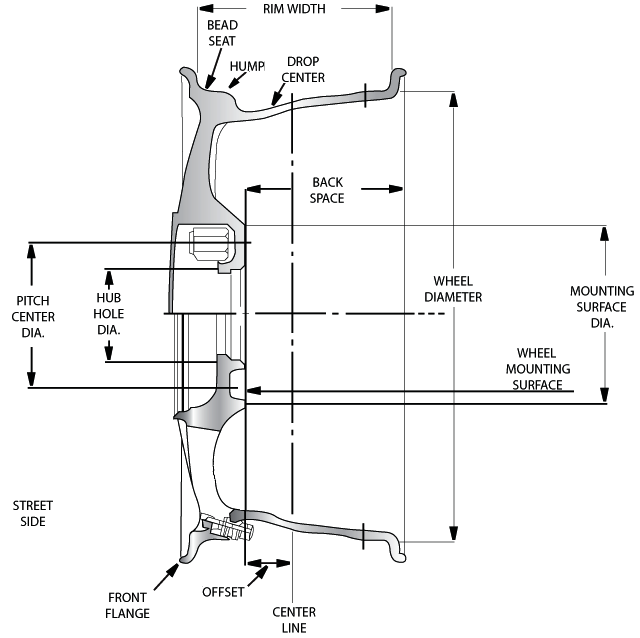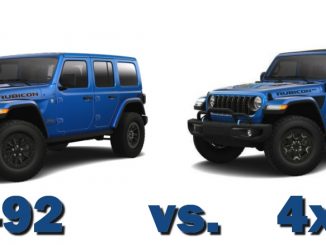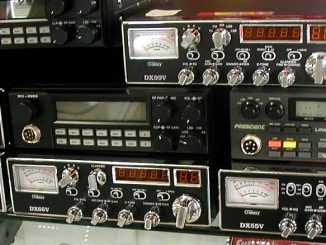
Offroaders.com Guide to Wheel Terminology. This guide helps you understand the most commonly used terms related to wheels including wheel construction, wheel measurements, sizing, and spacing.
Offset: The distance from the centerline of the wheel to the face of the mounting surface of the wheel that contacts the hub.
Negative offset: Indicates the mounting pad is behind (or inboard) the centerline of the rim. This is often found on standard rear-wheel-drive vehicles and on so-called reversed rims.
Positive offset: Refers to wheel s that have the mounting pad in front (or outboard) of the centerline of the rim. Most often found on front-drive applications.
Centerline: The exact center of the rim width. The width is measured between where the tires rest.
Bolt circle size: The bolt circle represents the diameter of an imaginary circle that goes through the center of the bolt holes (A). On a four-lug wheel, this is determined by measuring the distance between opposite holes (B). For a five-lug application, measure the center-to-center distance between two adjacent wheel studs (C) and reference the table below.
2.645 in. = 4 ½ in. circle
2.792 in. = 4 3/4 in. circle
2.939 in. = 5 in. circle
3.233 in. = 5 ½ circle
Moving up to a larger tire and wheel requires planning, considering the effects on gearing. The most important factor is the actual rolling height and width of the tire. Actual height often differs from nominal heights, so measuring the actual rolling radius of the tire would be the ideal way to know the exact effect on gearing, speedometer, etc. But measuring rolling tires, which may “grow” a little at speed, is impractical, so tires are measured as they sit.
There is no more practical method for sizing new tires than to simply tape measure the old against the (proposed) new rubber. For most calculations, this measurement is accurate enough. However, understanding tire-size nomenclature is important and will help immensely in getting the most tire with the least hassle.
Many types of high-performance specialty-tread truck tires are sized according to height, width, and wheel diameter. A tire listed as a 33/12.50R-15 is a 33-inch-tall radial (R), 12.50 inches wide and built for a 15-inch wheel. If there is no R in the designation, you can assume it is a bias-ply tire. Keep in mind, this 33-inch diameter is a nominal number which could vary by as much as seven percent (in this case, more than two full inches) according to industry standards.
Today, more and more tires built for light trucks and SUVs carry metric designations, which can be very helpful when figuring your tire and wheel upgrade. First, a few terms:
Diameter: The actual height of the tire measured through the center, in inches. Not always marked on the tire.
Section height: The vertical distance between the edge of the wheel rim and the top of the tire tread. Expressed in millimeters, this number is not usually marked on the tire.
Section width: The horizontal distance between the tire’s sidewalls. Expressed in millimeters, this number is usually the first number in a metric designation.
Aspect ratio: The relationship between section height and section width. The higher the aspect ratio number, the skinnier the tire, relative to its height. An aspect ratio of 75 means that section height is 75 percent of section width. A tire with a lower aspect ratio of 60 will have a “lower profile” than a 75, and a fatter look. This is normally the second number listed on a metric-sized tire.
LT : Metric tire designation a light truck tire.
ST : Designation for a trailer tire.
P : Designation for a passenger-car tire.
Looking at a tire marked LT305/85R16, the buyer knows that it is a 16-inch radial tire built for light trucks with an 85-percent aspect ratio and 305 millimeters of section width. To determine the height of the tire, you must calculate its section height in inches, dividing by 25.4, the number of millimeters in an inch (see equivalency chart). Next, convert the aspect ratio to a decimal by dividing by 100. Multiply the quotients of these two numbers to find the section height in inches. Double that figure and add the wheel diameter, and you will have the tire’s height. Using a 305/85R tire as an example, the equation works out as:
| 2 x section width x aspect ratio x aspect ratio + wheel size | |
| 25.4 | 100 |
| 2 x 305 x 85 + | 16 | = 36.4 inches |
| 25.4 | 100 |
Some of the most popular tire sizes, and their approximate metric equivalents can be found in the chart below.
| Flotation | Diameter (in.) | Metric size |
| 27×8.50R14 | 26.5 | 225/75R14 |
| 27.5 | 215/75R15 | |
| 29×9.50R15 | 28.5 | 235/75R15 |
| 30×9.50R15 | 29.5 | 245/75R15 |
| 31×10.50R15 | 30.5 | 265/75R15 |
| 32×11.50R15 | 31.5 | 295/75R15 |
| 33×12.50R15 | 32.5 | 315/70R15 |
| 33×12.50R16 | 32.8 | 285/75-16 |





